Marks & Spencer: Leadership, Management, and Operations Report
VerifiedAdded on 2020/10/04
|18
|5396
|294
Report
AI Summary
This report delves into the critical distinctions between leadership and management, exploring their respective roles and functions within an organizational context, specifically referencing Marks & Spencer (M&S) PLC. It begins by defining and comparing the characteristics of leaders and managers, highlighting their differing approaches to goal setting, risk management, and employee motivation. The report then examines how these roles manifest in various situational contexts, such as employee grievances, employee turnover, and interpersonal conflicts, providing real-world examples to illustrate the practical application of leadership and management principles. Furthermore, it applies different leadership theories and models, including situational leadership, systems leadership, and contingency leadership, to demonstrate how these frameworks can be utilized to address operational challenges and achieve business objectives within M&S. The report also explores the importance and value of operations management in achieving business objectives. Finally, it assesses the impact of external factors on operational management and decision-making processes within the chosen organization, providing a comprehensive analysis of the interplay between leadership, management, and the business environment.
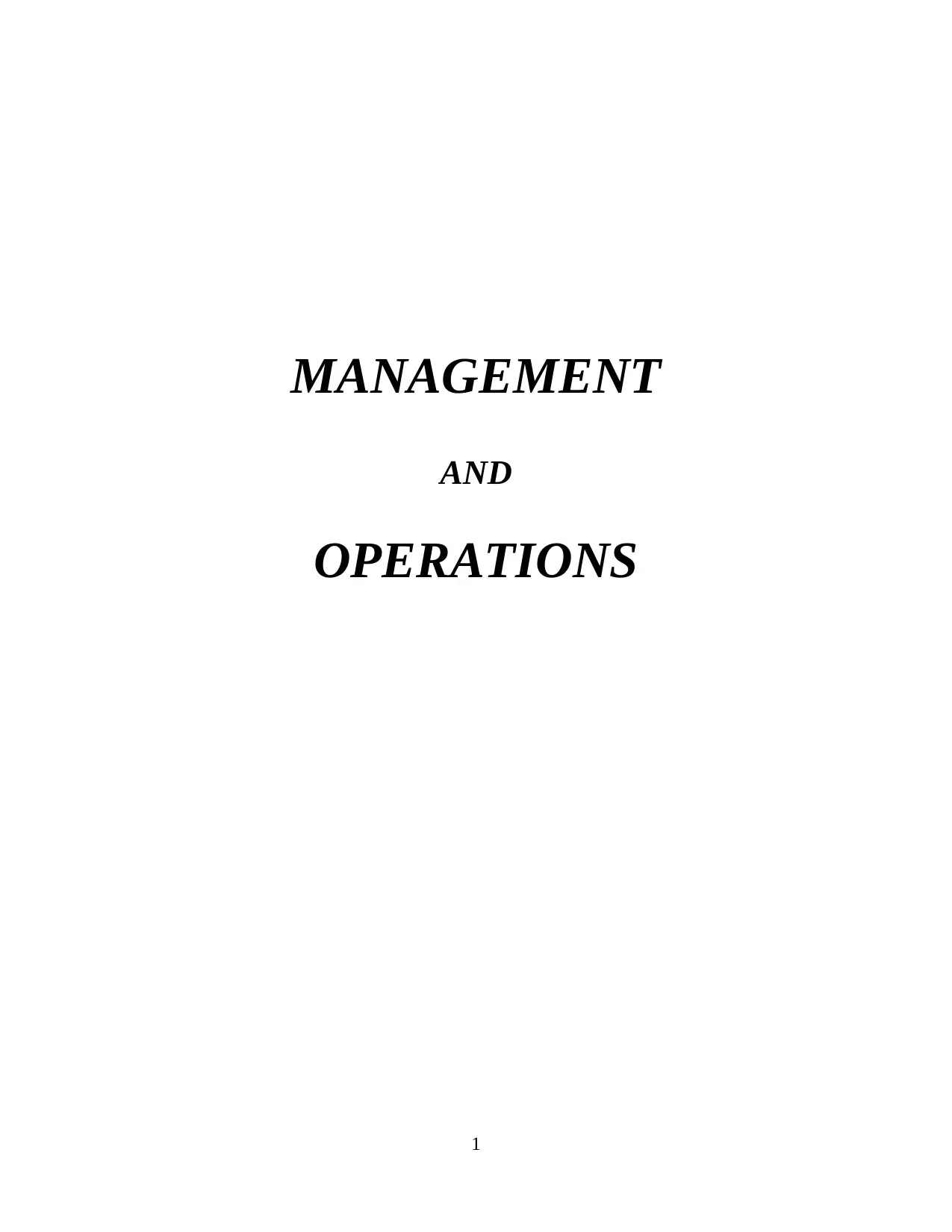
MANAGEMENT
AND
OPERATIONS
1
AND
OPERATIONS
1
Paraphrase This Document
Need a fresh take? Get an instant paraphrase of this document with our AI Paraphraser
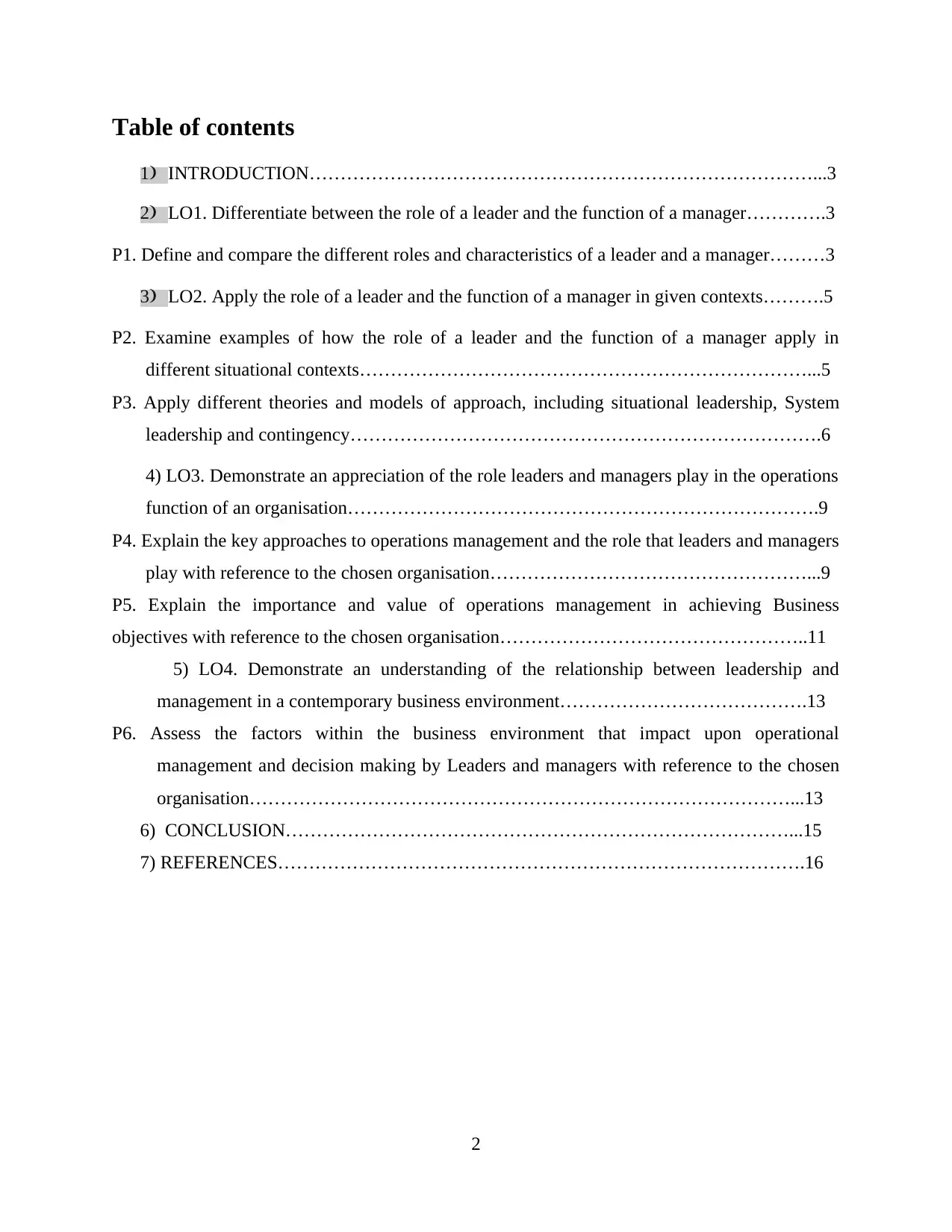
Table of contents
1) INTRODUCTION………………………………………………………………………...3
2) LO1. Differentiate between the role of a leader and the function of a manager………….3
P1. Define and compare the different roles and characteristics of a leader and a manager………3
3) LO2. Apply the role of a leader and the function of a manager in given contexts……….5
P2. Examine examples of how the role of a leader and the function of a manager apply in
different situational contexts………………………………………………………………...5
P3. Apply different theories and models of approach, including situational leadership, System
leadership and contingency………………………………………………………………….6
4) LO3. Demonstrate an appreciation of the role leaders and managers play in the operations
function of an organisation………………………………………………………………….9
P4. Explain the key approaches to operations management and the role that leaders and managers
play with reference to the chosen organisation……………………………………………...9
P5. Explain the importance and value of operations management in achieving Business
objectives with reference to the chosen organisation…………………………………………..11
5) LO4. Demonstrate an understanding of the relationship between leadership and
management in a contemporary business environment………………………………….13
P6. Assess the factors within the business environment that impact upon operational
management and decision making by Leaders and managers with reference to the chosen
organisation……………………………………………………………………………...13
6) CONCLUSION………………………………………………………………………...15
7) REFERENCES………………………………………………………………………….16
2
1) INTRODUCTION………………………………………………………………………...3
2) LO1. Differentiate between the role of a leader and the function of a manager………….3
P1. Define and compare the different roles and characteristics of a leader and a manager………3
3) LO2. Apply the role of a leader and the function of a manager in given contexts……….5
P2. Examine examples of how the role of a leader and the function of a manager apply in
different situational contexts………………………………………………………………...5
P3. Apply different theories and models of approach, including situational leadership, System
leadership and contingency………………………………………………………………….6
4) LO3. Demonstrate an appreciation of the role leaders and managers play in the operations
function of an organisation………………………………………………………………….9
P4. Explain the key approaches to operations management and the role that leaders and managers
play with reference to the chosen organisation……………………………………………...9
P5. Explain the importance and value of operations management in achieving Business
objectives with reference to the chosen organisation…………………………………………..11
5) LO4. Demonstrate an understanding of the relationship between leadership and
management in a contemporary business environment………………………………….13
P6. Assess the factors within the business environment that impact upon operational
management and decision making by Leaders and managers with reference to the chosen
organisation……………………………………………………………………………...13
6) CONCLUSION………………………………………………………………………...15
7) REFERENCES………………………………………………………………………….16
2
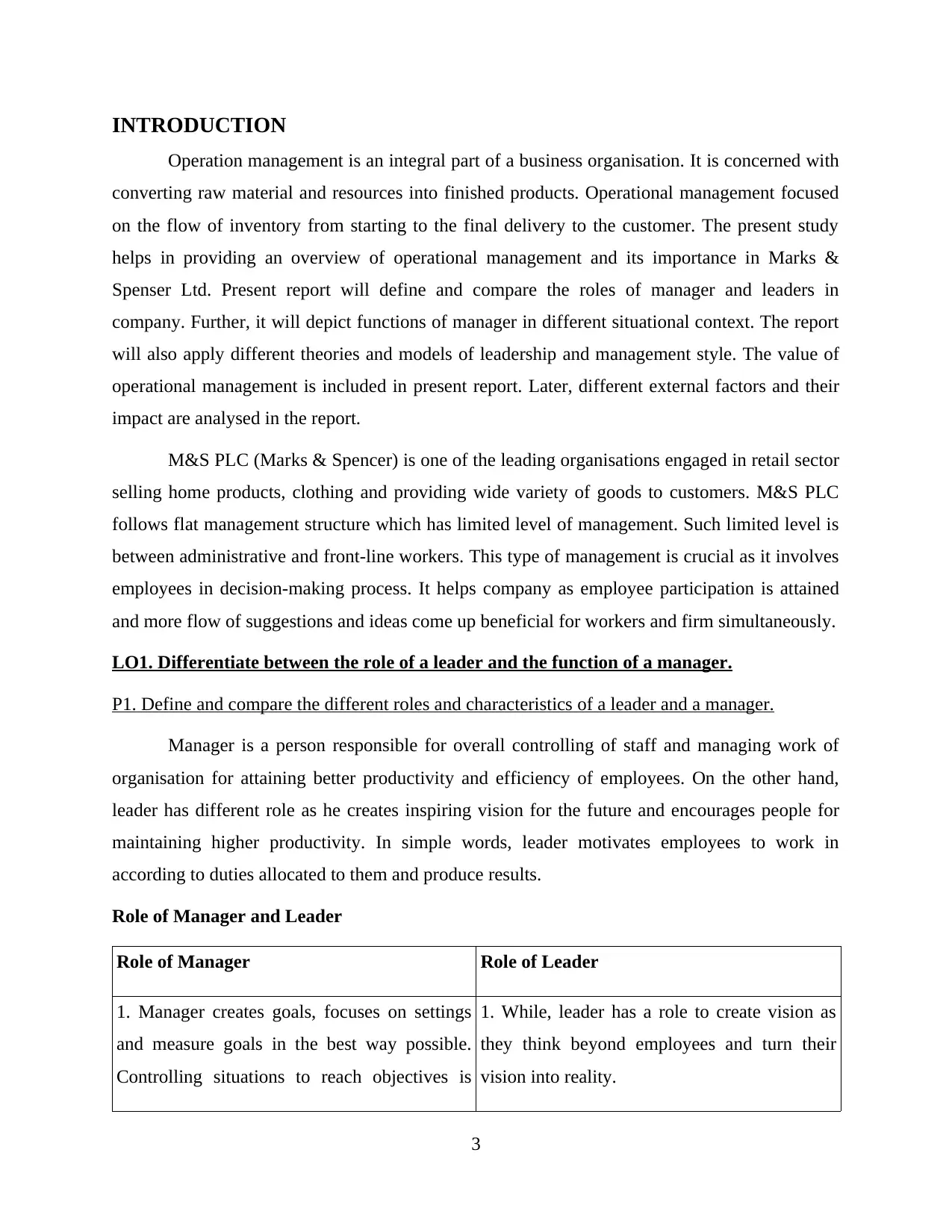
INTRODUCTION
Operation management is an integral part of a business organisation. It is concerned with
converting raw material and resources into finished products. Operational management focused
on the flow of inventory from starting to the final delivery to the customer. The present study
helps in providing an overview of operational management and its importance in Marks &
Spenser Ltd. Present report will define and compare the roles of manager and leaders in
company. Further, it will depict functions of manager in different situational context. The report
will also apply different theories and models of leadership and management style. The value of
operational management is included in present report. Later, different external factors and their
impact are analysed in the report.
M&S PLC (Marks & Spencer) is one of the leading organisations engaged in retail sector
selling home products, clothing and providing wide variety of goods to customers. M&S PLC
follows flat management structure which has limited level of management. Such limited level is
between administrative and front-line workers. This type of management is crucial as it involves
employees in decision-making process. It helps company as employee participation is attained
and more flow of suggestions and ideas come up beneficial for workers and firm simultaneously.
LO1. Differentiate between the role of a leader and the function of a manager.
P1. Define and compare the different roles and characteristics of a leader and a manager.
Manager is a person responsible for overall controlling of staff and managing work of
organisation for attaining better productivity and efficiency of employees. On the other hand,
leader has different role as he creates inspiring vision for the future and encourages people for
maintaining higher productivity. In simple words, leader motivates employees to work in
according to duties allocated to them and produce results.
Role of Manager and Leader
Role of Manager Role of Leader
1. Manager creates goals, focuses on settings
and measure goals in the best way possible.
Controlling situations to reach objectives is
1. While, leader has a role to create vision as
they think beyond employees and turn their
vision into reality.
3
Operation management is an integral part of a business organisation. It is concerned with
converting raw material and resources into finished products. Operational management focused
on the flow of inventory from starting to the final delivery to the customer. The present study
helps in providing an overview of operational management and its importance in Marks &
Spenser Ltd. Present report will define and compare the roles of manager and leaders in
company. Further, it will depict functions of manager in different situational context. The report
will also apply different theories and models of leadership and management style. The value of
operational management is included in present report. Later, different external factors and their
impact are analysed in the report.
M&S PLC (Marks & Spencer) is one of the leading organisations engaged in retail sector
selling home products, clothing and providing wide variety of goods to customers. M&S PLC
follows flat management structure which has limited level of management. Such limited level is
between administrative and front-line workers. This type of management is crucial as it involves
employees in decision-making process. It helps company as employee participation is attained
and more flow of suggestions and ideas come up beneficial for workers and firm simultaneously.
LO1. Differentiate between the role of a leader and the function of a manager.
P1. Define and compare the different roles and characteristics of a leader and a manager.
Manager is a person responsible for overall controlling of staff and managing work of
organisation for attaining better productivity and efficiency of employees. On the other hand,
leader has different role as he creates inspiring vision for the future and encourages people for
maintaining higher productivity. In simple words, leader motivates employees to work in
according to duties allocated to them and produce results.
Role of Manager and Leader
Role of Manager Role of Leader
1. Manager creates goals, focuses on settings
and measure goals in the best way possible.
Controlling situations to reach objectives is
1. While, leader has a role to create vision as
they think beyond employees and turn their
vision into reality.
3
⊘ This is a preview!⊘
Do you want full access?
Subscribe today to unlock all pages.

Trusted by 1+ million students worldwide
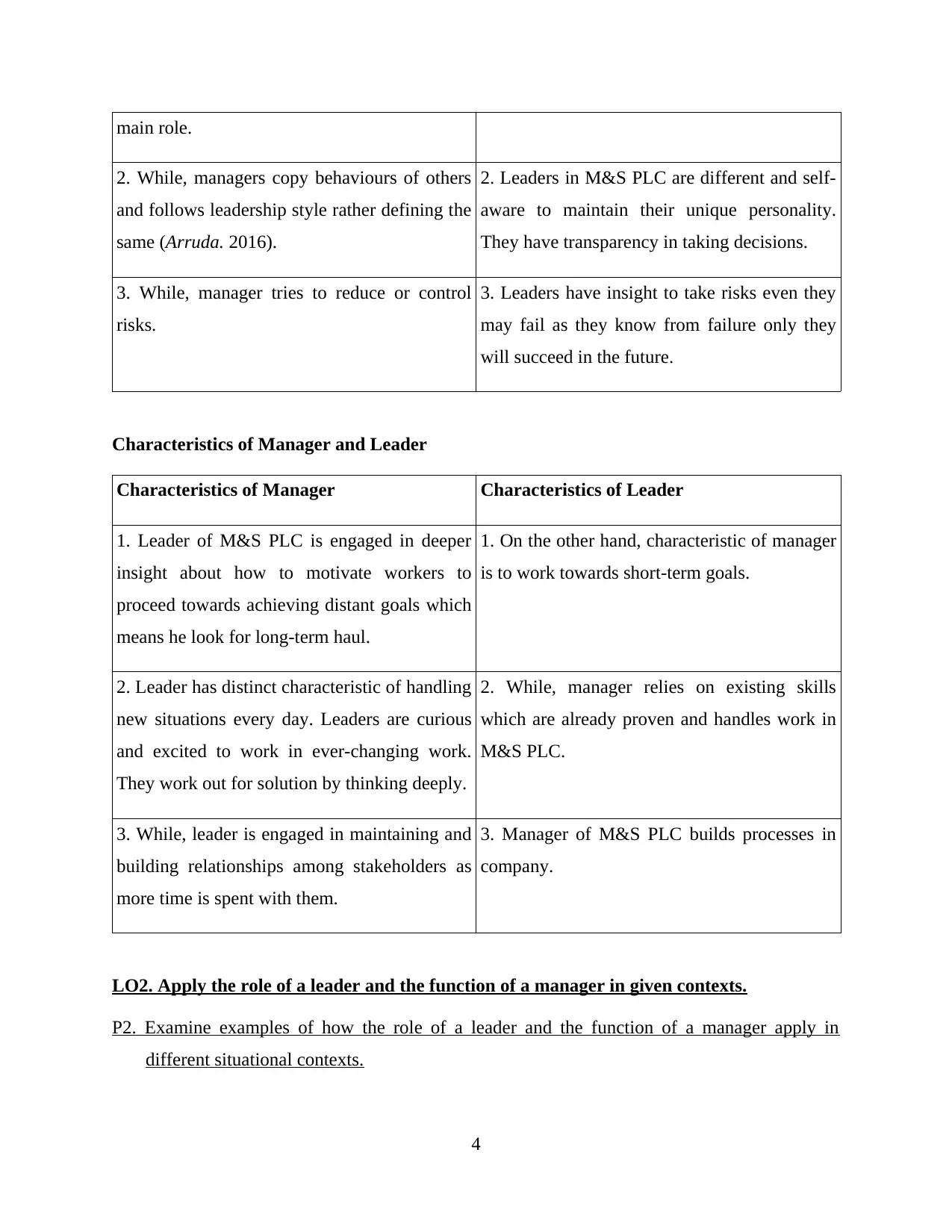
main role.
2. While, managers copy behaviours of others
and follows leadership style rather defining the
same (Arruda. 2016).
2. Leaders in M&S PLC are different and self-
aware to maintain their unique personality.
They have transparency in taking decisions.
3. While, manager tries to reduce or control
risks.
3. Leaders have insight to take risks even they
may fail as they know from failure only they
will succeed in the future.
Characteristics of Manager and Leader
Characteristics of Manager Characteristics of Leader
1. Leader of M&S PLC is engaged in deeper
insight about how to motivate workers to
proceed towards achieving distant goals which
means he look for long-term haul.
1. On the other hand, characteristic of manager
is to work towards short-term goals.
2. Leader has distinct characteristic of handling
new situations every day. Leaders are curious
and excited to work in ever-changing work.
They work out for solution by thinking deeply.
2. While, manager relies on existing skills
which are already proven and handles work in
M&S PLC.
3. While, leader is engaged in maintaining and
building relationships among stakeholders as
more time is spent with them.
3. Manager of M&S PLC builds processes in
company.
LO2. Apply the role of a leader and the function of a manager in given contexts.
P2. Examine examples of how the role of a leader and the function of a manager apply in
different situational contexts.
4
2. While, managers copy behaviours of others
and follows leadership style rather defining the
same (Arruda. 2016).
2. Leaders in M&S PLC are different and self-
aware to maintain their unique personality.
They have transparency in taking decisions.
3. While, manager tries to reduce or control
risks.
3. Leaders have insight to take risks even they
may fail as they know from failure only they
will succeed in the future.
Characteristics of Manager and Leader
Characteristics of Manager Characteristics of Leader
1. Leader of M&S PLC is engaged in deeper
insight about how to motivate workers to
proceed towards achieving distant goals which
means he look for long-term haul.
1. On the other hand, characteristic of manager
is to work towards short-term goals.
2. Leader has distinct characteristic of handling
new situations every day. Leaders are curious
and excited to work in ever-changing work.
They work out for solution by thinking deeply.
2. While, manager relies on existing skills
which are already proven and handles work in
M&S PLC.
3. While, leader is engaged in maintaining and
building relationships among stakeholders as
more time is spent with them.
3. Manager of M&S PLC builds processes in
company.
LO2. Apply the role of a leader and the function of a manager in given contexts.
P2. Examine examples of how the role of a leader and the function of a manager apply in
different situational contexts.
4
Paraphrase This Document
Need a fresh take? Get an instant paraphrase of this document with our AI Paraphraser
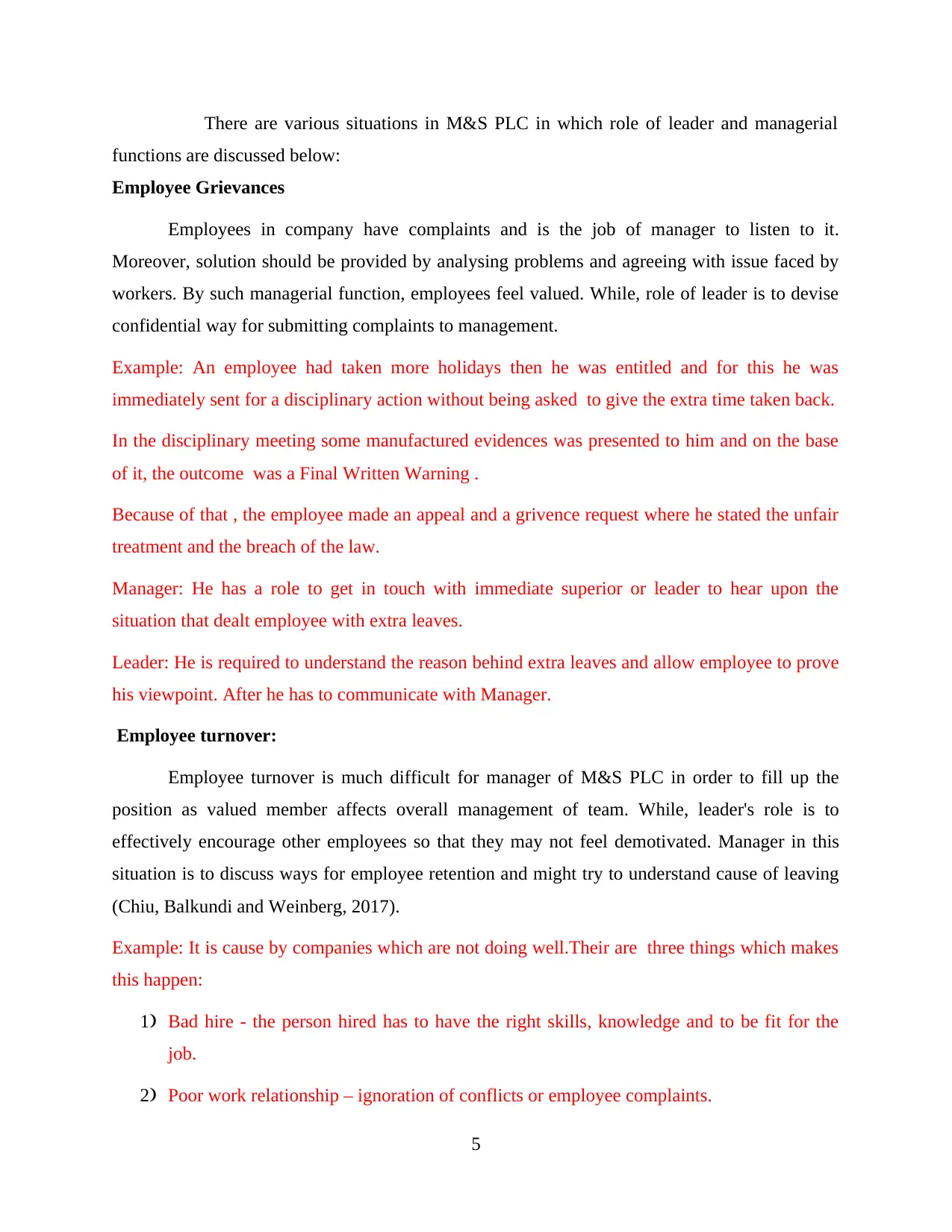
There are various situations in M&S PLC in which role of leader and managerial
functions are discussed below:
Employee Grievances
Employees in company have complaints and is the job of manager to listen to it.
Moreover, solution should be provided by analysing problems and agreeing with issue faced by
workers. By such managerial function, employees feel valued. While, role of leader is to devise
confidential way for submitting complaints to management.
Example: An employee had taken more holidays then he was entitled and for this he was
immediately sent for a disciplinary action without being asked to give the extra time taken back.
In the disciplinary meeting some manufactured evidences was presented to him and on the base
of it, the outcome was a Final Written Warning .
Because of that , the employee made an appeal and a grivence request where he stated the unfair
treatment and the breach of the law.
Manager: He has a role to get in touch with immediate superior or leader to hear upon the
situation that dealt employee with extra leaves.
Leader: He is required to understand the reason behind extra leaves and allow employee to prove
his viewpoint. After he has to communicate with Manager.
Employee turnover:
Employee turnover is much difficult for manager of M&S PLC in order to fill up the
position as valued member affects overall management of team. While, leader's role is to
effectively encourage other employees so that they may not feel demotivated. Manager in this
situation is to discuss ways for employee retention and might try to understand cause of leaving
(Chiu, Balkundi and Weinberg, 2017).
Example: It is cause by companies which are not doing well.Their are three things which makes
this happen:
1) Bad hire - the person hired has to have the right skills, knowledge and to be fit for the
job.
2) Poor work relationship – ignoration of conflicts or employee complaints.
5
functions are discussed below:
Employee Grievances
Employees in company have complaints and is the job of manager to listen to it.
Moreover, solution should be provided by analysing problems and agreeing with issue faced by
workers. By such managerial function, employees feel valued. While, role of leader is to devise
confidential way for submitting complaints to management.
Example: An employee had taken more holidays then he was entitled and for this he was
immediately sent for a disciplinary action without being asked to give the extra time taken back.
In the disciplinary meeting some manufactured evidences was presented to him and on the base
of it, the outcome was a Final Written Warning .
Because of that , the employee made an appeal and a grivence request where he stated the unfair
treatment and the breach of the law.
Manager: He has a role to get in touch with immediate superior or leader to hear upon the
situation that dealt employee with extra leaves.
Leader: He is required to understand the reason behind extra leaves and allow employee to prove
his viewpoint. After he has to communicate with Manager.
Employee turnover:
Employee turnover is much difficult for manager of M&S PLC in order to fill up the
position as valued member affects overall management of team. While, leader's role is to
effectively encourage other employees so that they may not feel demotivated. Manager in this
situation is to discuss ways for employee retention and might try to understand cause of leaving
(Chiu, Balkundi and Weinberg, 2017).
Example: It is cause by companies which are not doing well.Their are three things which makes
this happen:
1) Bad hire - the person hired has to have the right skills, knowledge and to be fit for the
job.
2) Poor work relationship – ignoration of conflicts or employee complaints.
5
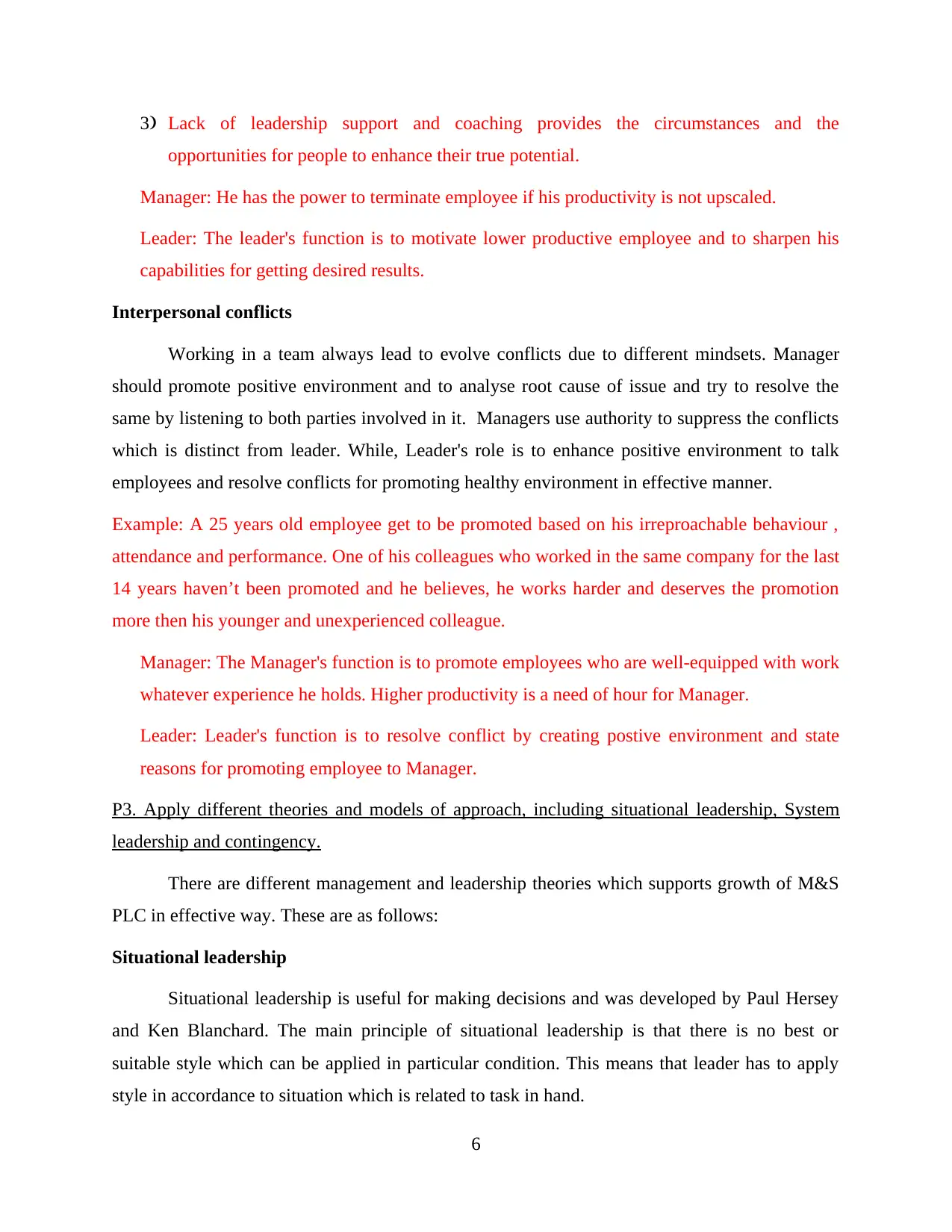
3) Lack of leadership support and coaching provides the circumstances and the
opportunities for people to enhance their true potential.
Manager: He has the power to terminate employee if his productivity is not upscaled.
Leader: The leader's function is to motivate lower productive employee and to sharpen his
capabilities for getting desired results.
Interpersonal conflicts
Working in a team always lead to evolve conflicts due to different mindsets. Manager
should promote positive environment and to analyse root cause of issue and try to resolve the
same by listening to both parties involved in it. Managers use authority to suppress the conflicts
which is distinct from leader. While, Leader's role is to enhance positive environment to talk
employees and resolve conflicts for promoting healthy environment in effective manner.
Example: A 25 years old employee get to be promoted based on his irreproachable behaviour ,
attendance and performance. One of his colleagues who worked in the same company for the last
14 years haven’t been promoted and he believes, he works harder and deserves the promotion
more then his younger and unexperienced colleague.
Manager: The Manager's function is to promote employees who are well-equipped with work
whatever experience he holds. Higher productivity is a need of hour for Manager.
Leader: Leader's function is to resolve conflict by creating postive environment and state
reasons for promoting employee to Manager.
P3. Apply different theories and models of approach, including situational leadership, System
leadership and contingency.
There are different management and leadership theories which supports growth of M&S
PLC in effective way. These are as follows:
Situational leadership
Situational leadership is useful for making decisions and was developed by Paul Hersey
and Ken Blanchard. The main principle of situational leadership is that there is no best or
suitable style which can be applied in particular condition. This means that leader has to apply
style in accordance to situation which is related to task in hand.
6
opportunities for people to enhance their true potential.
Manager: He has the power to terminate employee if his productivity is not upscaled.
Leader: The leader's function is to motivate lower productive employee and to sharpen his
capabilities for getting desired results.
Interpersonal conflicts
Working in a team always lead to evolve conflicts due to different mindsets. Manager
should promote positive environment and to analyse root cause of issue and try to resolve the
same by listening to both parties involved in it. Managers use authority to suppress the conflicts
which is distinct from leader. While, Leader's role is to enhance positive environment to talk
employees and resolve conflicts for promoting healthy environment in effective manner.
Example: A 25 years old employee get to be promoted based on his irreproachable behaviour ,
attendance and performance. One of his colleagues who worked in the same company for the last
14 years haven’t been promoted and he believes, he works harder and deserves the promotion
more then his younger and unexperienced colleague.
Manager: The Manager's function is to promote employees who are well-equipped with work
whatever experience he holds. Higher productivity is a need of hour for Manager.
Leader: Leader's function is to resolve conflict by creating postive environment and state
reasons for promoting employee to Manager.
P3. Apply different theories and models of approach, including situational leadership, System
leadership and contingency.
There are different management and leadership theories which supports growth of M&S
PLC in effective way. These are as follows:
Situational leadership
Situational leadership is useful for making decisions and was developed by Paul Hersey
and Ken Blanchard. The main principle of situational leadership is that there is no best or
suitable style which can be applied in particular condition. This means that leader has to apply
style in accordance to situation which is related to task in hand.
6
⊘ This is a preview!⊘
Do you want full access?
Subscribe today to unlock all pages.

Trusted by 1+ million students worldwide
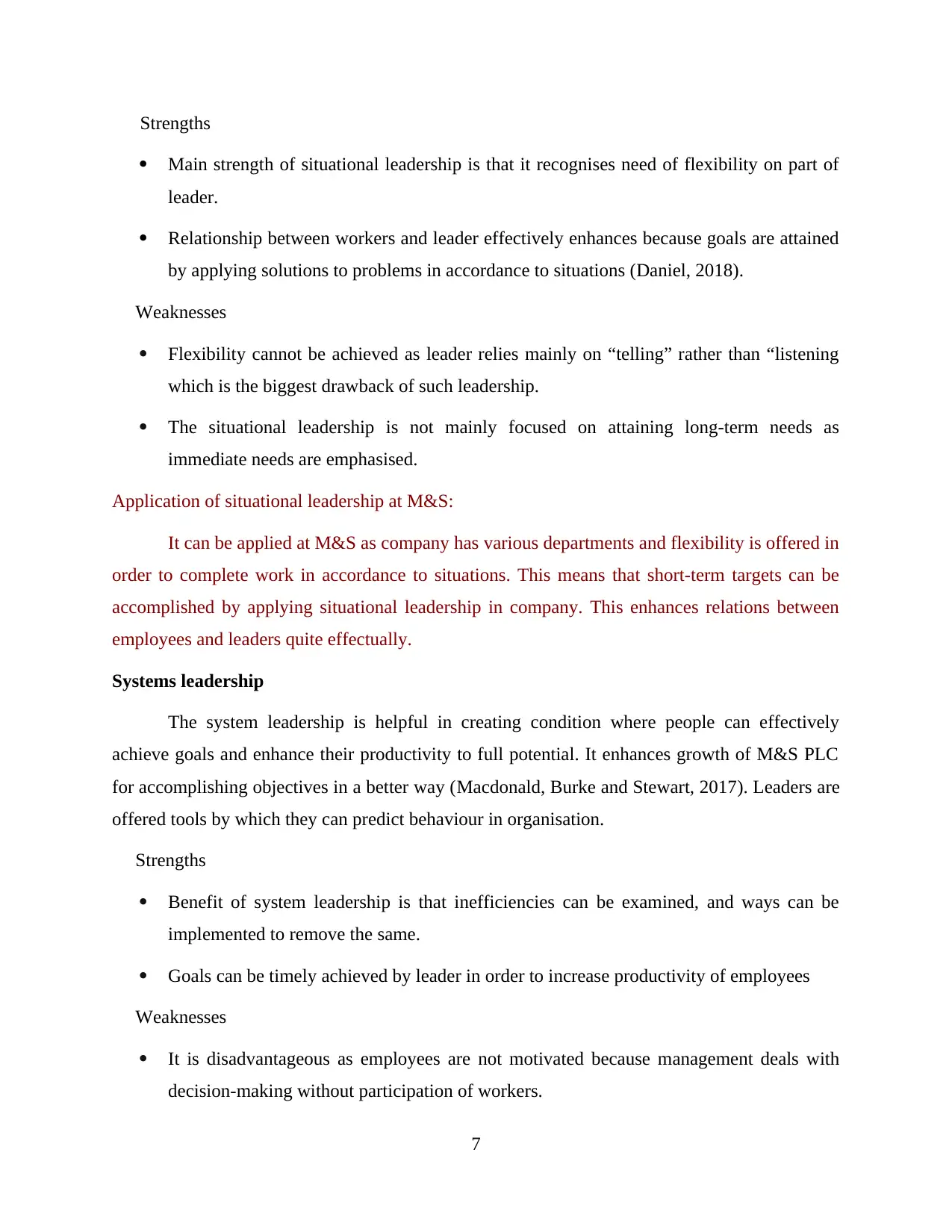
Strengths
Main strength of situational leadership is that it recognises need of flexibility on part of
leader.
Relationship between workers and leader effectively enhances because goals are attained
by applying solutions to problems in accordance to situations (Daniel, 2018).
Weaknesses
Flexibility cannot be achieved as leader relies mainly on “telling” rather than “listening
which is the biggest drawback of such leadership.
The situational leadership is not mainly focused on attaining long-term needs as
immediate needs are emphasised.
Application of situational leadership at M&S:
It can be applied at M&S as company has various departments and flexibility is offered in
order to complete work in accordance to situations. This means that short-term targets can be
accomplished by applying situational leadership in company. This enhances relations between
employees and leaders quite effectually.
Systems leadership
The system leadership is helpful in creating condition where people can effectively
achieve goals and enhance their productivity to full potential. It enhances growth of M&S PLC
for accomplishing objectives in a better way (Macdonald, Burke and Stewart, 2017). Leaders are
offered tools by which they can predict behaviour in organisation.
Strengths
Benefit of system leadership is that inefficiencies can be examined, and ways can be
implemented to remove the same.
Goals can be timely achieved by leader in order to increase productivity of employees
Weaknesses
It is disadvantageous as employees are not motivated because management deals with
decision-making without participation of workers.
7
Main strength of situational leadership is that it recognises need of flexibility on part of
leader.
Relationship between workers and leader effectively enhances because goals are attained
by applying solutions to problems in accordance to situations (Daniel, 2018).
Weaknesses
Flexibility cannot be achieved as leader relies mainly on “telling” rather than “listening
which is the biggest drawback of such leadership.
The situational leadership is not mainly focused on attaining long-term needs as
immediate needs are emphasised.
Application of situational leadership at M&S:
It can be applied at M&S as company has various departments and flexibility is offered in
order to complete work in accordance to situations. This means that short-term targets can be
accomplished by applying situational leadership in company. This enhances relations between
employees and leaders quite effectually.
Systems leadership
The system leadership is helpful in creating condition where people can effectively
achieve goals and enhance their productivity to full potential. It enhances growth of M&S PLC
for accomplishing objectives in a better way (Macdonald, Burke and Stewart, 2017). Leaders are
offered tools by which they can predict behaviour in organisation.
Strengths
Benefit of system leadership is that inefficiencies can be examined, and ways can be
implemented to remove the same.
Goals can be timely achieved by leader in order to increase productivity of employees
Weaknesses
It is disadvantageous as employees are not motivated because management deals with
decision-making without participation of workers.
7
Paraphrase This Document
Need a fresh take? Get an instant paraphrase of this document with our AI Paraphraser
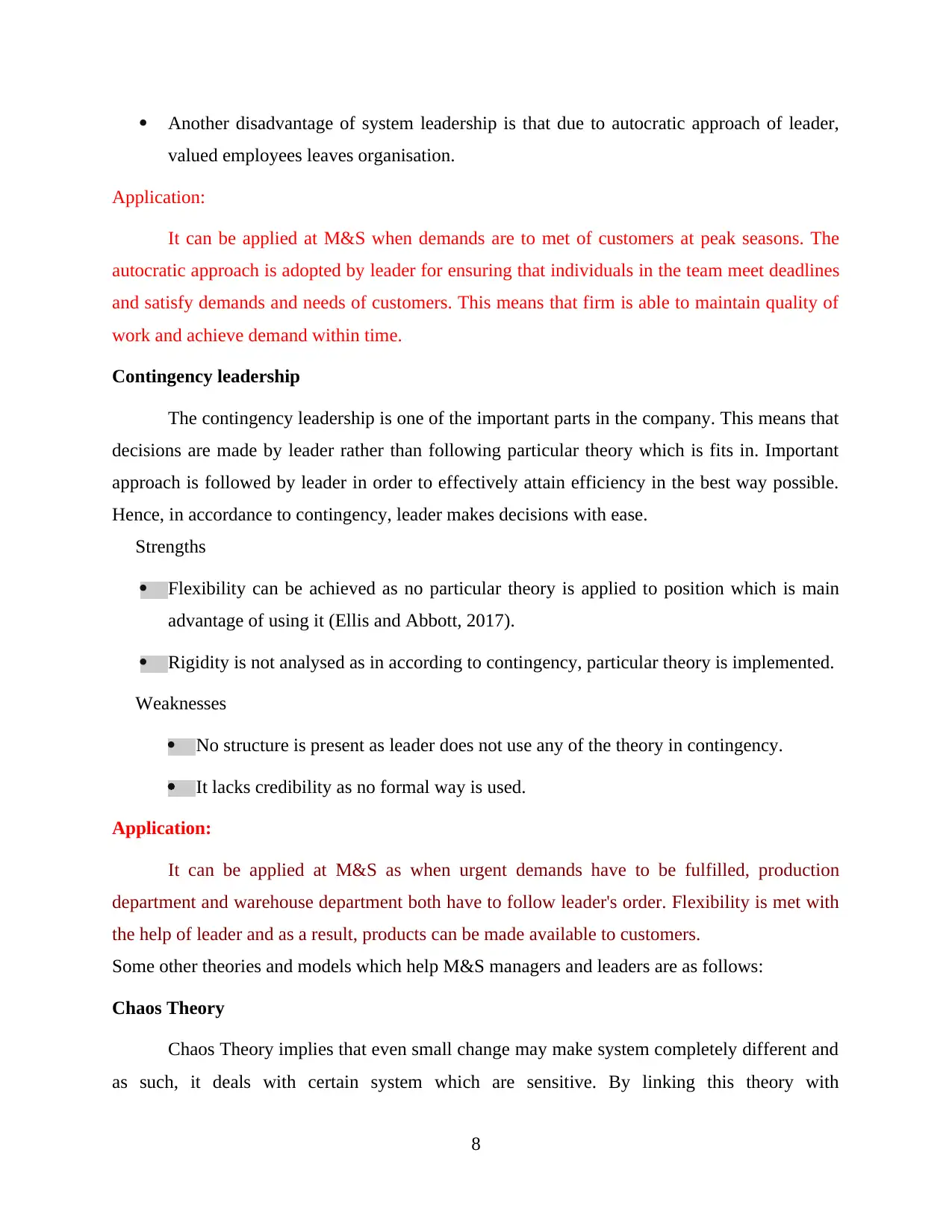
Another disadvantage of system leadership is that due to autocratic approach of leader,
valued employees leaves organisation.
Application:
It can be applied at M&S when demands are to met of customers at peak seasons. The
autocratic approach is adopted by leader for ensuring that individuals in the team meet deadlines
and satisfy demands and needs of customers. This means that firm is able to maintain quality of
work and achieve demand within time.
Contingency leadership
The contingency leadership is one of the important parts in the company. This means that
decisions are made by leader rather than following particular theory which is fits in. Important
approach is followed by leader in order to effectively attain efficiency in the best way possible.
Hence, in accordance to contingency, leader makes decisions with ease.
Strengths
Flexibility can be achieved as no particular theory is applied to position which is main
advantage of using it (Ellis and Abbott, 2017).
Rigidity is not analysed as in according to contingency, particular theory is implemented.
Weaknesses
No structure is present as leader does not use any of the theory in contingency.
It lacks credibility as no formal way is used.
Application:
It can be applied at M&S as when urgent demands have to be fulfilled, production
department and warehouse department both have to follow leader's order. Flexibility is met with
the help of leader and as a result, products can be made available to customers.
Some other theories and models which help M&S managers and leaders are as follows:
Chaos Theory
Chaos Theory implies that even small change may make system completely different and
as such, it deals with certain system which are sensitive. By linking this theory with
8
valued employees leaves organisation.
Application:
It can be applied at M&S when demands are to met of customers at peak seasons. The
autocratic approach is adopted by leader for ensuring that individuals in the team meet deadlines
and satisfy demands and needs of customers. This means that firm is able to maintain quality of
work and achieve demand within time.
Contingency leadership
The contingency leadership is one of the important parts in the company. This means that
decisions are made by leader rather than following particular theory which is fits in. Important
approach is followed by leader in order to effectively attain efficiency in the best way possible.
Hence, in accordance to contingency, leader makes decisions with ease.
Strengths
Flexibility can be achieved as no particular theory is applied to position which is main
advantage of using it (Ellis and Abbott, 2017).
Rigidity is not analysed as in according to contingency, particular theory is implemented.
Weaknesses
No structure is present as leader does not use any of the theory in contingency.
It lacks credibility as no formal way is used.
Application:
It can be applied at M&S as when urgent demands have to be fulfilled, production
department and warehouse department both have to follow leader's order. Flexibility is met with
the help of leader and as a result, products can be made available to customers.
Some other theories and models which help M&S managers and leaders are as follows:
Chaos Theory
Chaos Theory implies that even small change may make system completely different and
as such, it deals with certain system which are sensitive. By linking this theory with
8
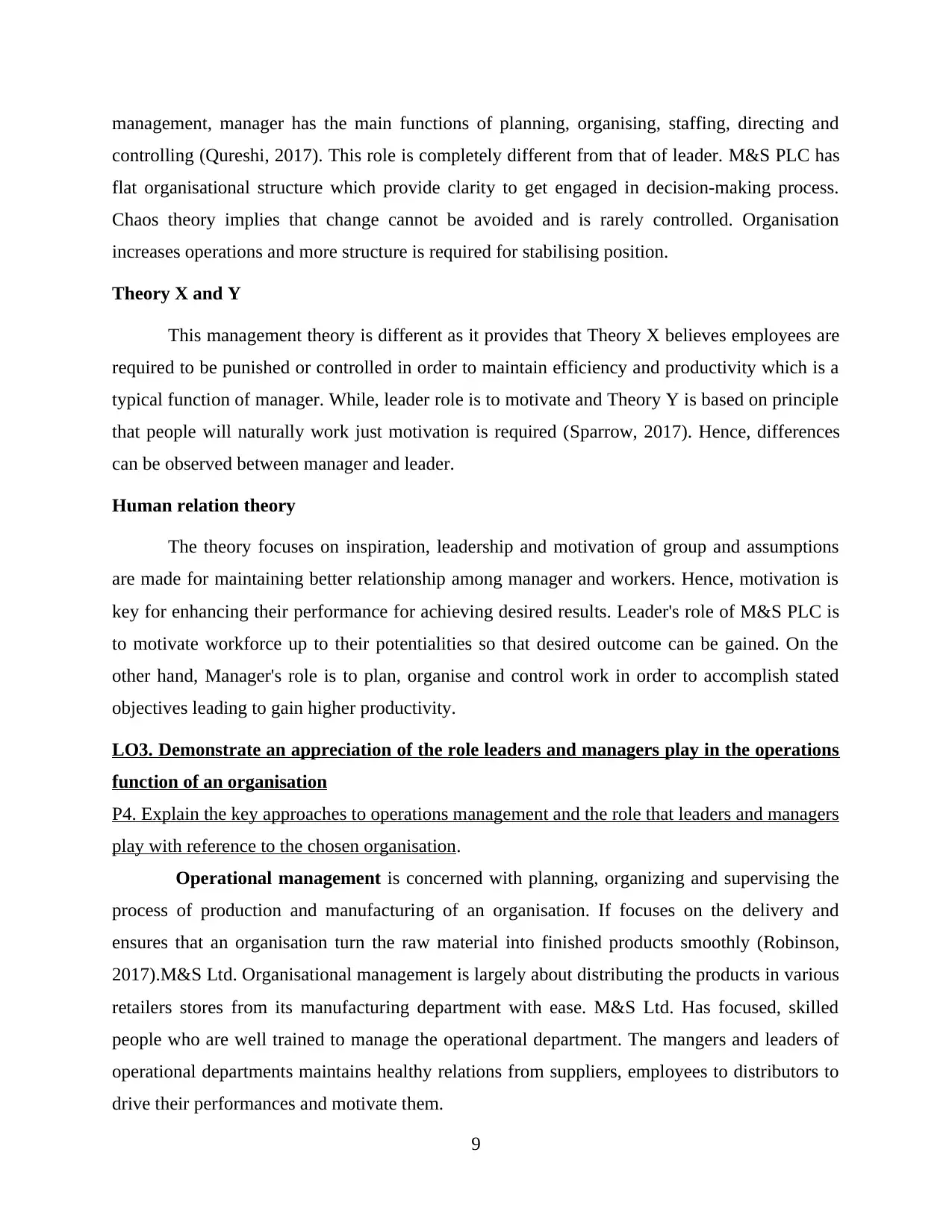
management, manager has the main functions of planning, organising, staffing, directing and
controlling (Qureshi, 2017). This role is completely different from that of leader. M&S PLC has
flat organisational structure which provide clarity to get engaged in decision-making process.
Chaos theory implies that change cannot be avoided and is rarely controlled. Organisation
increases operations and more structure is required for stabilising position.
Theory X and Y
This management theory is different as it provides that Theory X believes employees are
required to be punished or controlled in order to maintain efficiency and productivity which is a
typical function of manager. While, leader role is to motivate and Theory Y is based on principle
that people will naturally work just motivation is required (Sparrow, 2017). Hence, differences
can be observed between manager and leader.
Human relation theory
The theory focuses on inspiration, leadership and motivation of group and assumptions
are made for maintaining better relationship among manager and workers. Hence, motivation is
key for enhancing their performance for achieving desired results. Leader's role of M&S PLC is
to motivate workforce up to their potentialities so that desired outcome can be gained. On the
other hand, Manager's role is to plan, organise and control work in order to accomplish stated
objectives leading to gain higher productivity.
LO3. Demonstrate an appreciation of the role leaders and managers play in the operations
function of an organisation
P4. Explain the key approaches to operations management and the role that leaders and managers
play with reference to the chosen organisation.
Operational management is concerned with planning, organizing and supervising the
process of production and manufacturing of an organisation. If focuses on the delivery and
ensures that an organisation turn the raw material into finished products smoothly (Robinson,
2017).M&S Ltd. Organisational management is largely about distributing the products in various
retailers stores from its manufacturing department with ease. M&S Ltd. Has focused, skilled
people who are well trained to manage the operational department. The mangers and leaders of
operational departments maintains healthy relations from suppliers, employees to distributors to
drive their performances and motivate them.
9
controlling (Qureshi, 2017). This role is completely different from that of leader. M&S PLC has
flat organisational structure which provide clarity to get engaged in decision-making process.
Chaos theory implies that change cannot be avoided and is rarely controlled. Organisation
increases operations and more structure is required for stabilising position.
Theory X and Y
This management theory is different as it provides that Theory X believes employees are
required to be punished or controlled in order to maintain efficiency and productivity which is a
typical function of manager. While, leader role is to motivate and Theory Y is based on principle
that people will naturally work just motivation is required (Sparrow, 2017). Hence, differences
can be observed between manager and leader.
Human relation theory
The theory focuses on inspiration, leadership and motivation of group and assumptions
are made for maintaining better relationship among manager and workers. Hence, motivation is
key for enhancing their performance for achieving desired results. Leader's role of M&S PLC is
to motivate workforce up to their potentialities so that desired outcome can be gained. On the
other hand, Manager's role is to plan, organise and control work in order to accomplish stated
objectives leading to gain higher productivity.
LO3. Demonstrate an appreciation of the role leaders and managers play in the operations
function of an organisation
P4. Explain the key approaches to operations management and the role that leaders and managers
play with reference to the chosen organisation.
Operational management is concerned with planning, organizing and supervising the
process of production and manufacturing of an organisation. If focuses on the delivery and
ensures that an organisation turn the raw material into finished products smoothly (Robinson,
2017).M&S Ltd. Organisational management is largely about distributing the products in various
retailers stores from its manufacturing department with ease. M&S Ltd. Has focused, skilled
people who are well trained to manage the operational department. The mangers and leaders of
operational departments maintains healthy relations from suppliers, employees to distributors to
drive their performances and motivate them.
9
⊘ This is a preview!⊘
Do you want full access?
Subscribe today to unlock all pages.

Trusted by 1+ million students worldwide
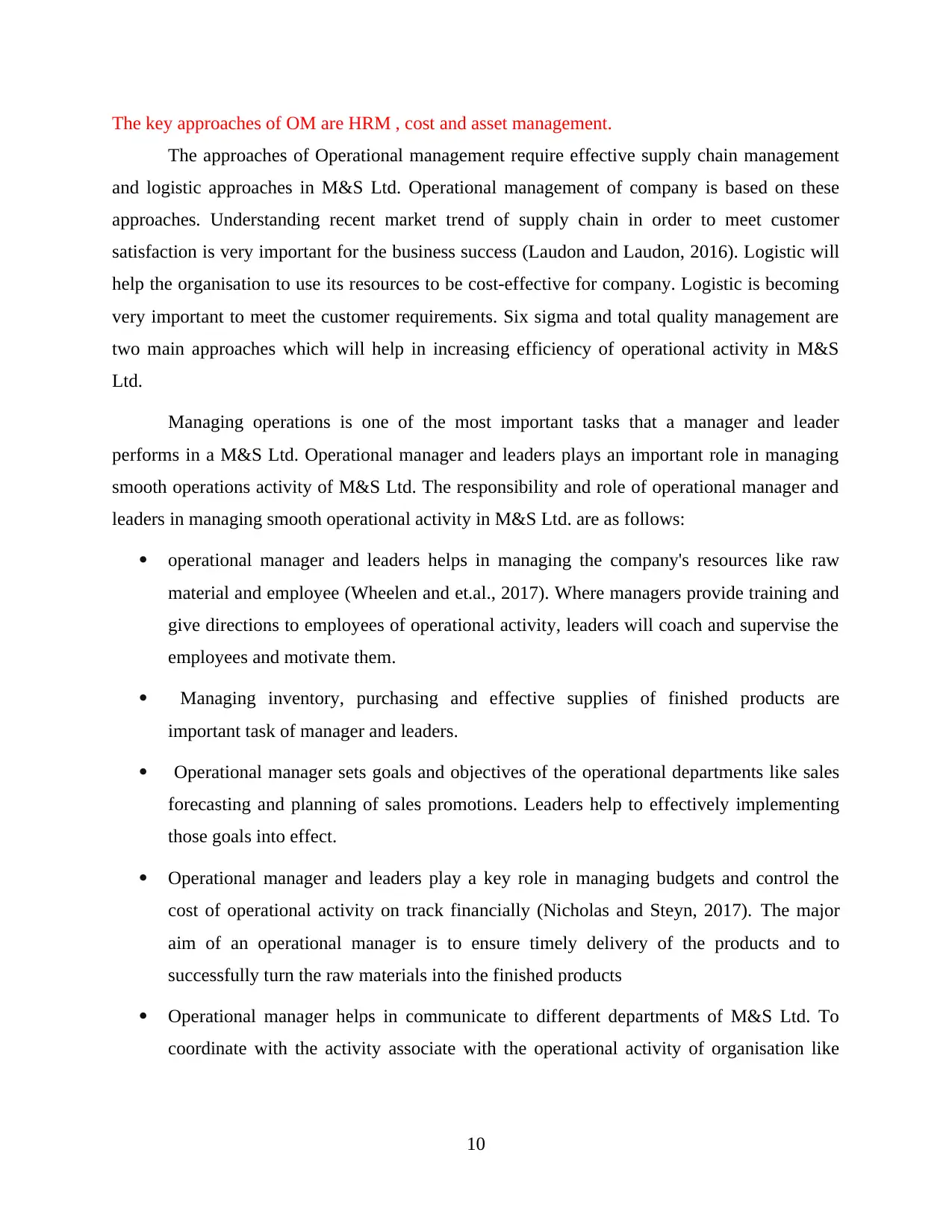
The key approaches of OM are HRM , cost and asset management.
The approaches of Operational management require effective supply chain management
and logistic approaches in M&S Ltd. Operational management of company is based on these
approaches. Understanding recent market trend of supply chain in order to meet customer
satisfaction is very important for the business success (Laudon and Laudon, 2016). Logistic will
help the organisation to use its resources to be cost-effective for company. Logistic is becoming
very important to meet the customer requirements. Six sigma and total quality management are
two main approaches which will help in increasing efficiency of operational activity in M&S
Ltd.
Managing operations is one of the most important tasks that a manager and leader
performs in a M&S Ltd. Operational manager and leaders plays an important role in managing
smooth operations activity of M&S Ltd. The responsibility and role of operational manager and
leaders in managing smooth operational activity in M&S Ltd. are as follows:
operational manager and leaders helps in managing the company's resources like raw
material and employee (Wheelen and et.al., 2017). Where managers provide training and
give directions to employees of operational activity, leaders will coach and supervise the
employees and motivate them.
Managing inventory, purchasing and effective supplies of finished products are
important task of manager and leaders.
Operational manager sets goals and objectives of the operational departments like sales
forecasting and planning of sales promotions. Leaders help to effectively implementing
those goals into effect.
Operational manager and leaders play a key role in managing budgets and control the
cost of operational activity on track financially (Nicholas and Steyn, 2017). The major
aim of an operational manager is to ensure timely delivery of the products and to
successfully turn the raw materials into the finished products
Operational manager helps in communicate to different departments of M&S Ltd. To
coordinate with the activity associate with the operational activity of organisation like
10
The approaches of Operational management require effective supply chain management
and logistic approaches in M&S Ltd. Operational management of company is based on these
approaches. Understanding recent market trend of supply chain in order to meet customer
satisfaction is very important for the business success (Laudon and Laudon, 2016). Logistic will
help the organisation to use its resources to be cost-effective for company. Logistic is becoming
very important to meet the customer requirements. Six sigma and total quality management are
two main approaches which will help in increasing efficiency of operational activity in M&S
Ltd.
Managing operations is one of the most important tasks that a manager and leader
performs in a M&S Ltd. Operational manager and leaders plays an important role in managing
smooth operations activity of M&S Ltd. The responsibility and role of operational manager and
leaders in managing smooth operational activity in M&S Ltd. are as follows:
operational manager and leaders helps in managing the company's resources like raw
material and employee (Wheelen and et.al., 2017). Where managers provide training and
give directions to employees of operational activity, leaders will coach and supervise the
employees and motivate them.
Managing inventory, purchasing and effective supplies of finished products are
important task of manager and leaders.
Operational manager sets goals and objectives of the operational departments like sales
forecasting and planning of sales promotions. Leaders help to effectively implementing
those goals into effect.
Operational manager and leaders play a key role in managing budgets and control the
cost of operational activity on track financially (Nicholas and Steyn, 2017). The major
aim of an operational manager is to ensure timely delivery of the products and to
successfully turn the raw materials into the finished products
Operational manager helps in communicate to different departments of M&S Ltd. To
coordinate with the activity associate with the operational activity of organisation like
10
Paraphrase This Document
Need a fresh take? Get an instant paraphrase of this document with our AI Paraphraser
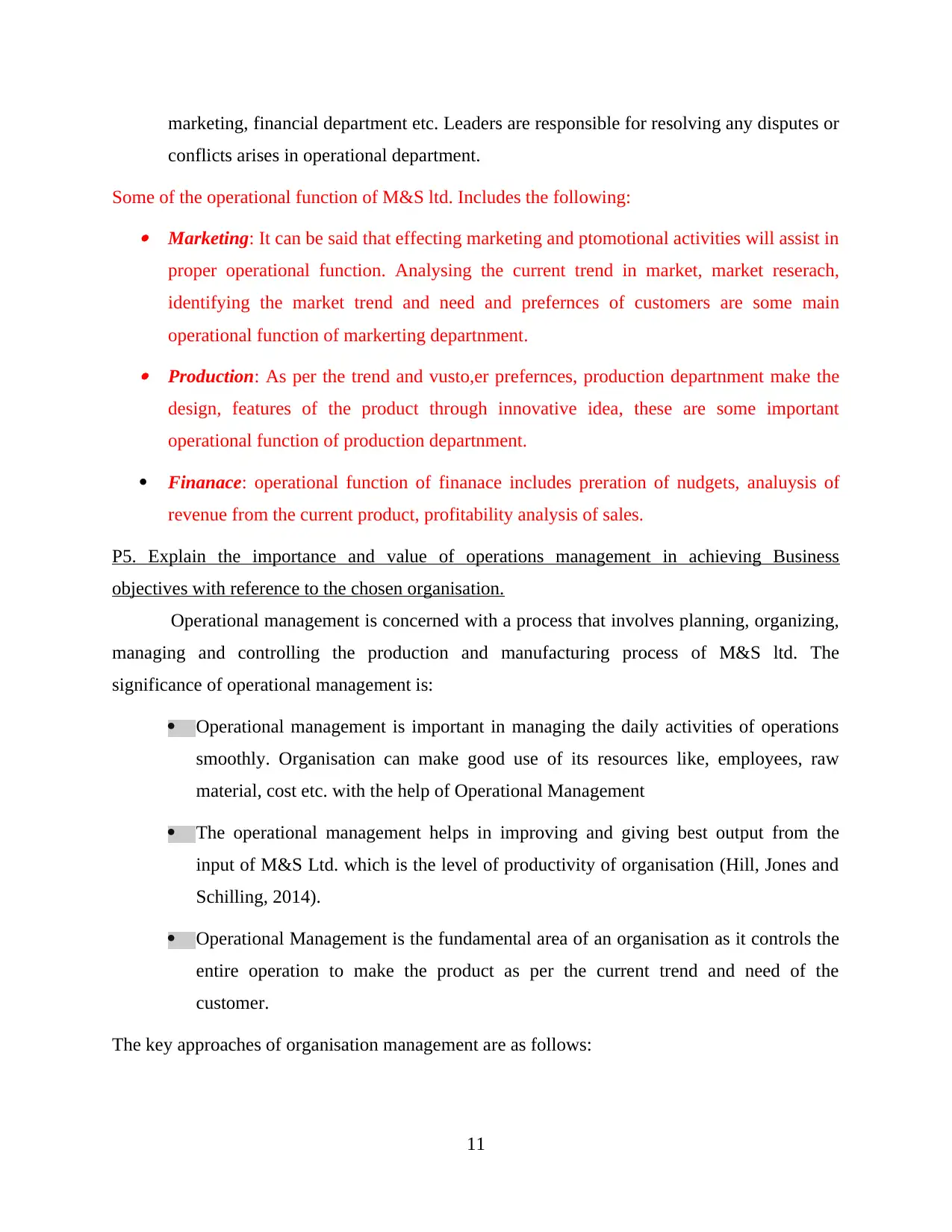
marketing, financial department etc. Leaders are responsible for resolving any disputes or
conflicts arises in operational department.
Some of the operational function of M&S ltd. Includes the following: Marketing: It can be said that effecting marketing and ptomotional activities will assist in
proper operational function. Analysing the current trend in market, market reserach,
identifying the market trend and need and prefernces of customers are some main
operational function of markerting departnment. Production: As per the trend and vusto,er prefernces, production departnment make the
design, features of the product through innovative idea, these are some important
operational function of production departnment.
Finanace: operational function of finanace includes preration of nudgets, analuysis of
revenue from the current product, profitability analysis of sales.
P5. Explain the importance and value of operations management in achieving Business
objectives with reference to the chosen organisation.
Operational management is concerned with a process that involves planning, organizing,
managing and controlling the production and manufacturing process of M&S ltd. The
significance of operational management is:
Operational management is important in managing the daily activities of operations
smoothly. Organisation can make good use of its resources like, employees, raw
material, cost etc. with the help of Operational Management
The operational management helps in improving and giving best output from the
input of M&S Ltd. which is the level of productivity of organisation (Hill, Jones and
Schilling, 2014).
Operational Management is the fundamental area of an organisation as it controls the
entire operation to make the product as per the current trend and need of the
customer.
The key approaches of organisation management are as follows:
11
conflicts arises in operational department.
Some of the operational function of M&S ltd. Includes the following: Marketing: It can be said that effecting marketing and ptomotional activities will assist in
proper operational function. Analysing the current trend in market, market reserach,
identifying the market trend and need and prefernces of customers are some main
operational function of markerting departnment. Production: As per the trend and vusto,er prefernces, production departnment make the
design, features of the product through innovative idea, these are some important
operational function of production departnment.
Finanace: operational function of finanace includes preration of nudgets, analuysis of
revenue from the current product, profitability analysis of sales.
P5. Explain the importance and value of operations management in achieving Business
objectives with reference to the chosen organisation.
Operational management is concerned with a process that involves planning, organizing,
managing and controlling the production and manufacturing process of M&S ltd. The
significance of operational management is:
Operational management is important in managing the daily activities of operations
smoothly. Organisation can make good use of its resources like, employees, raw
material, cost etc. with the help of Operational Management
The operational management helps in improving and giving best output from the
input of M&S Ltd. which is the level of productivity of organisation (Hill, Jones and
Schilling, 2014).
Operational Management is the fundamental area of an organisation as it controls the
entire operation to make the product as per the current trend and need of the
customer.
The key approaches of organisation management are as follows:
11
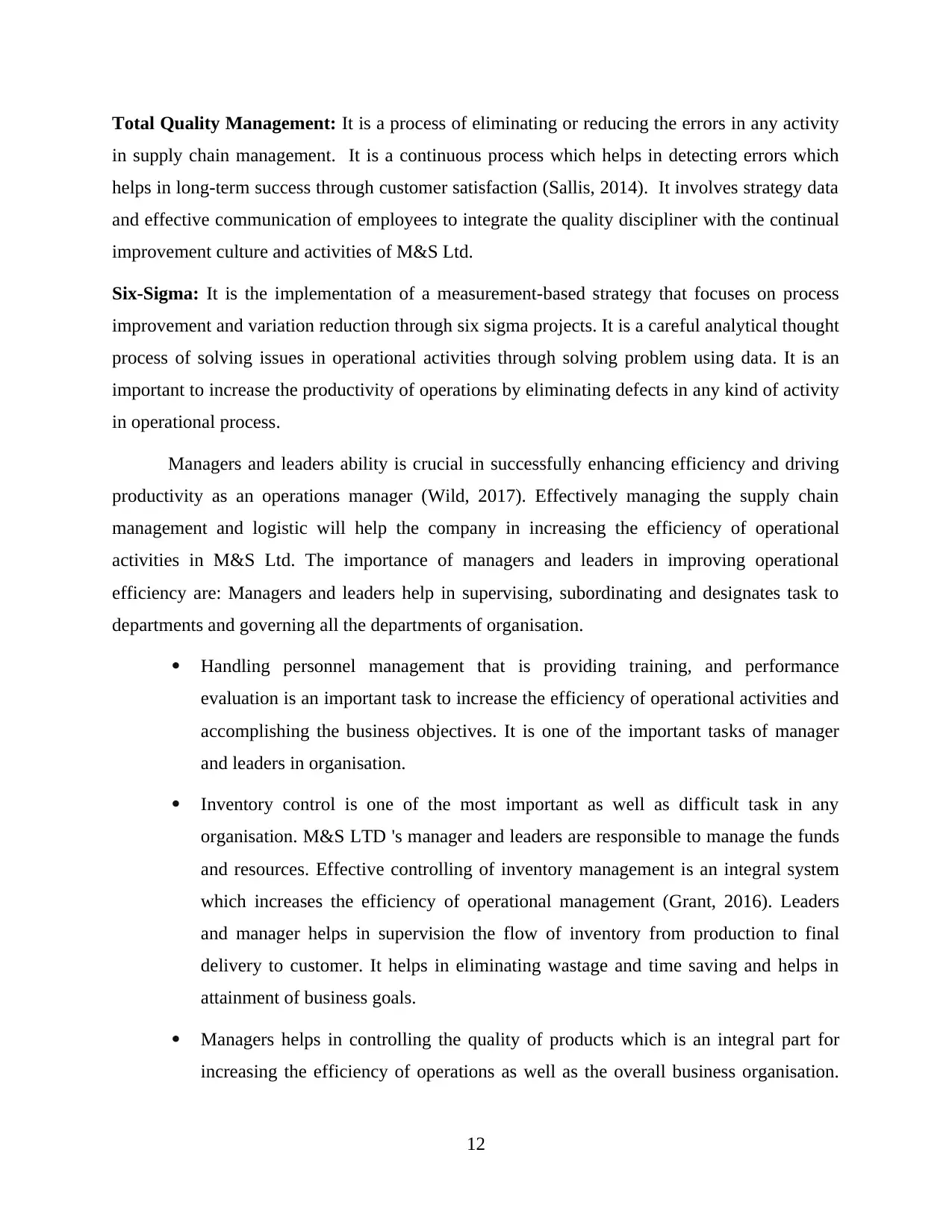
Total Quality Management: It is a process of eliminating or reducing the errors in any activity
in supply chain management. It is a continuous process which helps in detecting errors which
helps in long-term success through customer satisfaction (Sallis, 2014). It involves strategy data
and effective communication of employees to integrate the quality discipliner with the continual
improvement culture and activities of M&S Ltd.
Six-Sigma: It is the implementation of a measurement-based strategy that focuses on process
improvement and variation reduction through six sigma projects. It is a careful analytical thought
process of solving issues in operational activities through solving problem using data. It is an
important to increase the productivity of operations by eliminating defects in any kind of activity
in operational process.
Managers and leaders ability is crucial in successfully enhancing efficiency and driving
productivity as an operations manager (Wild, 2017). Effectively managing the supply chain
management and logistic will help the company in increasing the efficiency of operational
activities in M&S Ltd. The importance of managers and leaders in improving operational
efficiency are: Managers and leaders help in supervising, subordinating and designates task to
departments and governing all the departments of organisation.
Handling personnel management that is providing training, and performance
evaluation is an important task to increase the efficiency of operational activities and
accomplishing the business objectives. It is one of the important tasks of manager
and leaders in organisation.
Inventory control is one of the most important as well as difficult task in any
organisation. M&S LTD 's manager and leaders are responsible to manage the funds
and resources. Effective controlling of inventory management is an integral system
which increases the efficiency of operational management (Grant, 2016). Leaders
and manager helps in supervision the flow of inventory from production to final
delivery to customer. It helps in eliminating wastage and time saving and helps in
attainment of business goals.
Managers helps in controlling the quality of products which is an integral part for
increasing the efficiency of operations as well as the overall business organisation.
12
in supply chain management. It is a continuous process which helps in detecting errors which
helps in long-term success through customer satisfaction (Sallis, 2014). It involves strategy data
and effective communication of employees to integrate the quality discipliner with the continual
improvement culture and activities of M&S Ltd.
Six-Sigma: It is the implementation of a measurement-based strategy that focuses on process
improvement and variation reduction through six sigma projects. It is a careful analytical thought
process of solving issues in operational activities through solving problem using data. It is an
important to increase the productivity of operations by eliminating defects in any kind of activity
in operational process.
Managers and leaders ability is crucial in successfully enhancing efficiency and driving
productivity as an operations manager (Wild, 2017). Effectively managing the supply chain
management and logistic will help the company in increasing the efficiency of operational
activities in M&S Ltd. The importance of managers and leaders in improving operational
efficiency are: Managers and leaders help in supervising, subordinating and designates task to
departments and governing all the departments of organisation.
Handling personnel management that is providing training, and performance
evaluation is an important task to increase the efficiency of operational activities and
accomplishing the business objectives. It is one of the important tasks of manager
and leaders in organisation.
Inventory control is one of the most important as well as difficult task in any
organisation. M&S LTD 's manager and leaders are responsible to manage the funds
and resources. Effective controlling of inventory management is an integral system
which increases the efficiency of operational management (Grant, 2016). Leaders
and manager helps in supervision the flow of inventory from production to final
delivery to customer. It helps in eliminating wastage and time saving and helps in
attainment of business goals.
Managers helps in controlling the quality of products which is an integral part for
increasing the efficiency of operations as well as the overall business organisation.
12
⊘ This is a preview!⊘
Do you want full access?
Subscribe today to unlock all pages.

Trusted by 1+ million students worldwide
1 out of 18
Related Documents
Your All-in-One AI-Powered Toolkit for Academic Success.
+13062052269
info@desklib.com
Available 24*7 on WhatsApp / Email
![[object Object]](/_next/static/media/star-bottom.7253800d.svg)
Unlock your academic potential
Copyright © 2020–2025 A2Z Services. All Rights Reserved. Developed and managed by ZUCOL.




